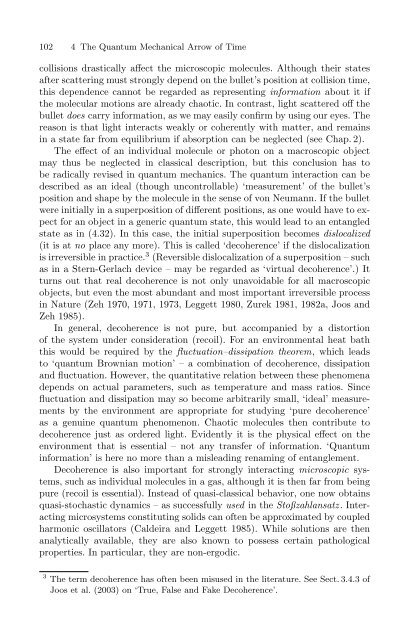The Physical Basis of The Direction of Time (The Frontiers ...
The Physical Basis of The Direction of Time (The Frontiers ...
The Physical Basis of The Direction of Time (The Frontiers ...
Create successful ePaper yourself
Turn your PDF publications into a flip-book with our unique Google optimized e-Paper software.
102 4 <strong>The</strong> Quantum Mechanical Arrow <strong>of</strong> <strong>Time</strong><br />
collisions drastically affect the microscopic molecules. Although their states<br />
after scattering must strongly depend on the bullet’s position at collision time,<br />
this dependence cannot be regarded as representing information about it if<br />
the molecular motions are already chaotic. In contrast, light scattered <strong>of</strong>f the<br />
bullet does carry information, as we may easily confirm by using our eyes. <strong>The</strong><br />
reason is that light interacts weakly or coherently with matter, and remains<br />
in a state far from equilibrium if absorption can be neglected (see Chap. 2).<br />
<strong>The</strong> effect <strong>of</strong> an individual molecule or photon on a macroscopic object<br />
may thus be neglected in classical description, but this conclusion has to<br />
be radically revised in quantum mechanics. <strong>The</strong> quantum interaction can be<br />
described as an ideal (though uncontrollable) ‘measurement’ <strong>of</strong> the bullet’s<br />
position and shape by the molecule in the sense <strong>of</strong> von Neumann. If the bullet<br />
were initially in a superposition <strong>of</strong> different positions, as one would have to expect<br />
for an object in a generic quantum state, this would lead to an entangled<br />
state as in (4.32). In this case, the initial superposition becomes dislocalized<br />
(it is at no place any more). This is called ‘decoherence’ if the dislocalization<br />
is irreversible in practice. 3 (Reversible dislocalization <strong>of</strong> a superposition – such<br />
as in a Stern-Gerlach device – may be regarded as ‘virtual decoherence’.) It<br />
turns out that real decoherence is not only unavoidable for all macroscopic<br />
objects, but even the most abundant and most important irreversible process<br />
in Nature (Zeh 1970, 1971, 1973, Leggett 1980, Zurek 1981, 1982a, Joos and<br />
Zeh 1985).<br />
In general, decoherence is not pure, but accompanied by a distortion<br />
<strong>of</strong> the system under consideration (recoil). For an environmental heat bath<br />
this would be required by the fluctuation–dissipation theorem, which leads<br />
to ‘quantum Brownian motion’ – a combination <strong>of</strong> decoherence, dissipation<br />
and fluctuation. However, the quantitative relation between these phenomena<br />
depends on actual parameters, such as temperature and mass ratios. Since<br />
fluctuation and dissipation may so become arbitrarily small, ‘ideal’ measurements<br />
by the environment are appropriate for studying ‘pure decoherence’<br />
as a genuine quantum phenomenon. Chaotic molecules then contribute to<br />
decoherence just as ordered light. Evidently it is the physical effect on the<br />
environment that is essential – not any transfer <strong>of</strong> information. ‘Quantum<br />
information’ is here no more than a misleading renaming <strong>of</strong> entanglement.<br />
Decoherence is also important for strongly interacting microscopic systems,<br />
such as individual molecules in a gas, although it is then far from being<br />
pure (recoil is essential). Instead <strong>of</strong> quasi-classical behavior, one now obtains<br />
quasi-stochastic dynamics – as successfully used in the Stoßzahlansatz. Interacting<br />
microsystems constituting solids can <strong>of</strong>ten be approximated by coupled<br />
harmonic oscillators (Caldeira and Leggett 1985). While solutions are then<br />
analytically available, they are also known to possess certain pathological<br />
properties. In particular, they are non-ergodic.<br />
3 <strong>The</strong> term decoherence has <strong>of</strong>ten been misused in the literature. See Sect. 3.4.3 <strong>of</strong><br />
Joos et al. (2003) on ‘True, False and Fake Decoherence’.



![arXiv:1001.0993v1 [hep-ph] 6 Jan 2010](https://img.yumpu.com/51282177/1/190x245/arxiv10010993v1-hep-ph-6-jan-2010.jpg?quality=85)


![arXiv:1008.3907v2 [astro-ph.CO] 1 Nov 2011](https://img.yumpu.com/48909562/1/190x245/arxiv10083907v2-astro-phco-1-nov-2011.jpg?quality=85)








![arXiv:1002.4928v1 [gr-qc] 26 Feb 2010](https://img.yumpu.com/41209516/1/190x245/arxiv10024928v1-gr-qc-26-feb-2010.jpg?quality=85)
![arXiv:1206.2653v1 [astro-ph.CO] 12 Jun 2012](https://img.yumpu.com/39510078/1/190x245/arxiv12062653v1-astro-phco-12-jun-2012.jpg?quality=85)
